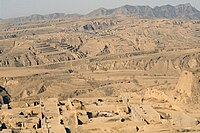
Photo from wikipedia
Abstract Every year about one third of the geohazards in China occur in the Loess Plateau causing human loss, damaging gas and oil pipelines, destroying highways, railways and degrading farmland.… Click to show full abstract
Abstract Every year about one third of the geohazards in China occur in the Loess Plateau causing human loss, damaging gas and oil pipelines, destroying highways, railways and degrading farmland. Field investigation and monitoring, in-situ tests and laboratory experiments were performed to improve our understanding of the factors effecting the distribution, characteristics and causes of loess landslides. First, we find that 79% of the landslides are shallower than10m, 85% have a volume of less than 100,000 m3. Second, landslides on the Loess Plateau occur primarily on concave slope profiles that have slope angles of 20–35° and that face south-east. Third, the equivalent coefficient of friction of loess landslides is very low resulting in long run-out with a low angle sliding surface. Loess landslides generally transform into mud-flows resulting in an increase in volume in transit and forming a geohazard chain. Antecedent rainfall plays an important role in triggering loess landslides. Finally, clusters of landslides in the Loess Plateau occur because the loess easily disintegrates under high pressure due to its loose and highly porous structure. There is a sharp decrease in cohesive strength with increase in deformation and water content and thus landslides tend to undergo static liquefaction during sliding.
Journal Title: Engineering Geology
Year Published: 2017
Link to full text (if available)
Share on Social Media: Sign Up to like & get
recommendations!